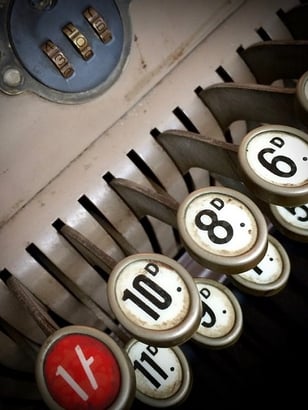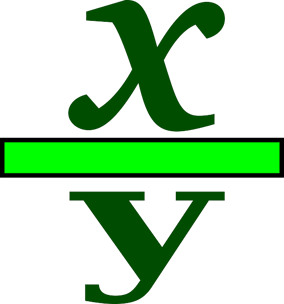
Wondering how to convert decimals to fractions? Or how to convert fractions to decimals? It’s easier than you think! Keep reading to see the steps for decimal to fraction conversions (including why you need to follow different steps if you have a repeating decimal), steps for fraction to decimal conversions, a handy chart with common decimal/fraction conversions, and tips for quickly estimating conversions.
How to Convert Decimals to Fractions
How do you convert a decimal to a fraction? Any decimal, even complicated-looking ones, can be converted to a fraction; you just need to follow a few steps. Below we explain how to convert both terminating decimals and repeating decimals to fractions.
Converting a Terminating Decimal to a Fraction
A terminating decimal is any decimal that has a finite other of digits. In other words, it has an end. Examples include .5, .234, .864721, etc. Terminating decimals are the most common decimals you’ll see and, fortunately, they are also the easiest to convert to fractions.
Step 1
Write the decimal divided by one.
For example, say you’re given the decimal .55. Your first step is to write out the decimal so it looks like ${.55}/{1}$.
Step 2
Next, you want to multiply both the top and bottom of your new fraction by 10 for every digit to the left of the decimal point.
In our example, .55 has two digits after the decimal point, so we’ll want to multiply the entire fraction by 10 x 10, or 100. Multiplying the fraction by ${100}/{100}$ gives us ${55}/{100}$.
Step 3
The final step is reducing the fraction to its simplest form. The simplest form of the fraction is when the top and bottom of the fraction are the smallest whole numbers they can be. For example, the fraction ${3}/{9}$ isn’t in its simplest form because it can still be reduced down to ⅓ by dividing both the top and bottom of the fraction by 3.
The fraction ${55}/{100}$ can be reduced by dividing both the top and bottom of the fraction by 5, giving us ${11}/{20}$. 11 is a prime number and can’t be divided any more, so we know this is the fraction in its simplest form.
The decimal .55 is equal to the fraction ${11}/{20}$.
Example
Convert .108 to a fraction.
After putting the decimal over 1, we end up with ${.108}/{1}$.
Since .108 has three digits after the decimal place, we need to multiply the entire fraction by 10 x 10 x 10, or 1000. This gives us ${108}/{1000}$.
Now we need to simplify. Since 108 and 1000 are both even numbers, we know we can divide both by 2. This gives us ${54}/{500}$. These are still even numbers, so we can divide by 2 again to get ${27}/{250}$. 27 isn't a factor of 250, so the fraction can’t be reduced any more.
The final answer is ${27}/{250}$.

Converting a Repeating Decimal to a Fraction
A repeating decimal is one that has no end. Since you can’t keep writing or typing the decimal out forever, they are often written as a string of digits rounded off (.666666667) or with a bar above the repeating digit(s) $\ov {(.6)}$.
For our example, we’ll convert .6667 to a fraction.
The decimal .6667 is equal to $\ov {(.6)}$, .666666667, .667, etc. They’re all just different ways to show that the decimal is actually a string of 6’s that goes on forever.
Step 1
Let x equal the repeating decimal you’re trying to convert, and identify the repeating digit(s).
So x=.6667
6 is the repeating digit, and the end of the decimal has been rounded up.
Step 2
Multiply by whatever value of 10 you need to get the repeating digit(s) on the left side of the decimal.
For .6667, we know that 6 is the repeating digit. We want that six on the left side of the decimal, which means moving the decimal place over one spot. So we multiply both sides of the equation by (10 x 1) or 10.
10x = 6.667
Note: You only want one “set” of repeating digit(s) on the left side of the decimal. In this example, with 6 as the repeating digit, you only want one 6 on the left of the decimal. If the decimal was 0.58585858, you’d only want one set of “58” on the left side. If it helps, you can picture all repeating decimals with the infinity bar over them, so .6667 would be $\ov {(.6)}$.
Step 3
Next we want to get an equation where the repeating digit is just to the right of the decimal.
Looking at x = .6667, we can see that the repeating digit (6) is already just to the right of the decimal, so we don’t need to do any multiplication. We’ll keep this equation as x = .6667
Step 4
Now we need to solve for x using our two equations, x = .667 and 10x = 6.667.
10x - x =6.667-.667
9x = 6
x = ${6}/{9}$
x = ⅔
Example
Convert 1.0363636 to a fraction.
This question is a bit trickier, but we’ll be doing the same steps that we did above.
First, make the decimal equal to x, and determine the repeating digit(s). x = 1.0363636 and the repeating digits are 3 and 6
Next, get the repeating digits on the left side of the decimal (again, you only want one set of repeating digits on the left). This involves moving the decimal three places to the right, so both sides need to be multiplied by (10 x 3) or 1000.
1000x = 1036.363636
Now get the repeating digits to the right of the decimal. Looking at the equation x = 1.0363636, you can see that there currently is a zero between the decimal and the repeating digits. The decimal needs to be moved over one space, so both sides need to be multiplied by 10 x 1.
10x = 10.363636
Now use the two equations, 1000x = 1036.363636 and 10x = 10.363636, to solve for x.
1000x - 10x = 1036.363636 - 10.363636
990x = 1026
x = ${1026}/{990}$
Since the numerator is larger than the denominator, this is known as an irregular fraction. Sometimes you can leave the fraction as an irregular fraction, or you may be asked to convert it to a regular fraction. You can do this by subtracting 990/990 from the fraction and making it a 1 that’ll go next to the fraction.
${1026}/{990}$ - ${990}/{990}$ = 1 ${36}/{990}$
x = 1 ${36}/{990}$
${36}/{990}$ can be simplified by dividing it by 18.
x = 1 ${2}/{55}$

How to Convert Fractions to Decimals
The easiest way to convert a fraction to a decimal is just to use your calculator. The line between the numerator and denominator acts as a division line, so ${7}/{29}$ equals 7 divided by 29 or .241.
If you don’t have access to a calculator though, you can still convert fractions to decimals by using long division or getting the denominator to equal a multiple of 10. We explain both these methods in this section.
Long Division Method
Convert ${3}/{8}$ to a decimal.
Here is what ${3}/{8}$ looks like worked out with long division.

⅜ converted to a decimal is .375
Denominator as a Value of 10 Method
Convert ${3}/{8}$ to a decimal.
Step 1
We want the denominator, in this case 8, to equal a value of 10. We can do this by multiplying the fraction by 125, giving us ${375}/{1000}$.
Step 2
Next we want to get the denominator to equal 1 so we can get rid of the fraction. We’ll do this by dividing each part of the fraction by 1000, which means moving the decimal over three places to the left.
This gives us ${.375}/{1}$ or just .375, which is our answer.
Note that this method only works for a fraction with a denominator that can easily be multiplied to be a value of 10. However, there is a trick you can use to estimate the value of fractions you can’t convert using this method. Check out the example below.
Example
Convert ⅔ to a decimal.
There is no number you can multiply 3 by to make it an exact multiple of 10, but you can get close.
By multiplying ⅔ by ${333}/{333}$, we get ${666}/{999}$.
999 is very close to 1000, so let’s act like it actually is 1000, divide each part of the fraction by 1000, and move the decimal place of 666 three places to the left, giving us .666
The exact decimal conversion of ⅔ is the repeating decimal .6666667, but .666 gets us very close.
So whenever you have a fraction whose denominator can’t easily be multiplied to a value of 10 (this will happen to all fractions that convert to repeating decimals), just get the denominator as close to a multiple of 10 as possible for a close estimate.
Common Decimal to Fraction Conversions
Below is a chart with common decimal to fraction conversions. You don’t need to memorize these, but knowing at least some of them off the top of your head will make it easy to do some common conversions. If you’re trying to convert a decimal or fraction and don’t have a calculator, you can also see which value in this chart the number is closest to so you can make an educated estimate of the conversion.
|
Decimal |
Fraction |
|
0.03125 |
${1}/{32}$ |
|
0.0625 |
${1}/{16}$ |
|
0.1 |
${1}/{10}$ |
|
0.1111 |
${1}/{9}$ |
|
0.125 |
${1}/{8}$ |
|
0.16667 |
${1}/{6}$ |
|
0.2 |
${1}/{5}$ |
|
0.2222 |
${2}/{9}$ |
|
0.25 |
${1}/{4}$ |
|
0.3 |
${3}/{10}$ |
|
0.3333 |
${1}/{3}$ |
|
0.375 |
${3}/{8}$ |
|
0.4 |
${2}/{5}$ |
|
0.4444 |
${4}/{9}$ |
|
0.5 |
${1}/{2}$ |
|
0.5555 |
${5}/{9}$ |
|
0.6 |
${3}/{5}$ |
|
0.625 |
${5}/{8}$ |
|
0.6666 |
${2}/{3}$ |
|
0.7 |
${7}/{10}$ |
|
0.75 |
${3}/{4}$ |
|
0.7777 |
${7}/{9}$ |
|
0.8 |
${4}/{5}$ |
|
0.8333 |
${5}/{6}$ |
|
0.875 |
${7}/{8}$ |
|
0.8888 |
${8}/{9}$ |
|
0.9 |
${9}/{10}$ |
Summary: How to Make a Decimal Into a Fraction
If you’re trying to convert a decimal to fraction, first you need to determine if it’s a terminal decimal (one with an end) or a repeating decimal (one with a digit or digit that repeats to infinity). Once you’ve done that, you can follow a few steps for the decimal to fraction conversion and for writing decimals as fractions.
If you’re trying to convert a fraction to decimal, the easiest way is just to use your calculator. If you don’t have one handy, you can use long division or get the denominator equal to a multiple of ten, then move the decimal place of the numerator over.
For quick estimates of decimal to fraction conversions (or vice versa), you can look at our chart of common conversions and see which is closest to your figure to get a ballpark idea of its conversion value.
What's Next?
Want to know the fastest and easiest ways to convert between Fahrenheit and Celsius? We've got you covered! Check out our guide to the best ways to convert Celsius to Fahrenheit (or vice versa).
Are you learning about logarithms and natural logs in math class? We have a guide on all the natural log rules you need to know.
Did you know that water has a very special density? Check out our guide to learn what the density of water is and how the density can change.
Have friends who also need help with test prep? Share this article!

Christine graduated from Michigan State University with degrees in Environmental Biology and Geography and received her Master's from Duke University. In high school she scored in the 99th percentile on the SAT and was named a National Merit Finalist. She has taught English and biology in several countries.

































 Holly R.
Holly R.